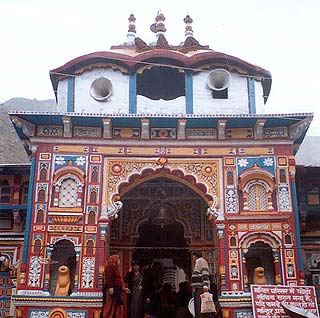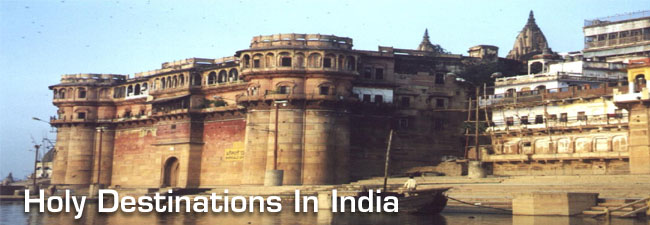 Pilgrimage
Attractions in Badrinath
Pilgrimage
Attractions in Badrinath
Excursions from Badrinath The Abode Of Lord Vishnu Cradled
in the twin mountain ranges of Nar and Narayan is the holiest
of the four main shrines, Badrinath along the left bank river
Alaknanda. With the splendid Neelkanth mountains as the backdrop,
it is an important destination on the scared itinerary of every
devour Hindu. Once the spot was carpeted with 'badris' or wild
berries and hence was famous as 'Badri Van'.
Badrinath is considered the holiest of the four important shrines
in Garhwal. The town is at an altitude of 3,133 m. above sea
level, situated on the left bank of river Alaknanda and exactly
between the two mountains Nara and Narayan. The shrine is dedicated
to Vishnu, the preserver and falls in the religious itinerary
of every devout Hindu.
Garhwal Kings built the present temple about two centuries
ago. It is a conical structure, 15 m. tall and has small cupola
of a gilt bull and spire. There are 15 idols in the temple complex,
each sculpted in black stone. The principal idol represents
Vishnu in a meditative posture and is flanked by Nara-Narayan.
Legend dates it prior to the Vedic age though it is believed
to have been re-established by Adi Shankaracharya, an important
Hindu saint in 8th century A.D. Some of the other images include
Laxmi (Vishnu's consort), Garud (Vishnu's mount), Shiva &
Parvati and Ganesha.
The temple has been renovated several times due to damages
by avalanches. It looks fairly modern now due to the colourful
"Singh Dwara" or the main entrance gate.
It has 3 parts :-
(i) Garbha Griha (the sanctum sanctorum),
(ii) Darshan Mandap (for pujas),
(iii) Shobha Mandap (for devotees to assemble).
The revered shrine is still alive with myriad legends from
mythology. Its sanctity is emphasised in the ancient scriptures
as "There are many sacred spots of pilgrimage in the heavens,
earth and the nether world, but there has been none equal to
Badri, nor shall there be".
Location and Access
State : Uttaranchal
Altitude : 3133 mtrs
Best Season : May to October
Temperature : Summer Max - 17 deg : Min - 5 deg
Accessibility
Airport - Jolly Grant (317 kms.)
Railhead - Rishikesh (300 kms.), Haridwar
(275 kms), Kotdwar (327 kms.)
Road - Well connected to Rishikesh, Haridwar,
Dehradun, Kotdwar and other hill stations of Garhwal and Kumaon
region.
Mythological Legend
Legend has it, when the Ganga was requested to descend to
earth to help suffering humanity; the earth was unable to withstand
the force of its descent. Therefore the mighty Ganaga was split
into twelve holy channels. Alaknanda was one of them that later
became the abode of Lord Vishnu or Badrinath.
The temple of Shri Badrinathji on the banks of the Alaknanda
River dates back to the vedic times. Situated at an altitude
of 3,133 mtrs, the present temple is believed to have been built
by Adi Guru Shankaracharya- an 8th century's philosopher-saint,
who also established a 'math' here. Also known as 'Vishal Badri',
Badrinath is one of the Panch Badris.
Panch Badris or Five Badris
Besides the main temple of Badrinath there are four other smaller
badri temples. These are collectively called the panch badris
or five badris. Very few pilgrims however, visit the other four
Badri temples.
• Yogadhyan Badri (1920 m.)
Closest to the main temple of Badrinath lies this tiny, sleepy
hamlet which remains unnoticed by most pilgrims and is the winter
home for the idol at Badrinath. Pandukeshwar is also an important
archaeological site. Some years ago, four ancient metal foils
engraved with a description of several kings in the region were
discovered here. Believed to be over 1500 years old, these foils
are kept at Joshimath, 30 km downstream.
• Bhavishya Badri (2,744 m.)
The bhavishya or future badri is situated at Subain near Tapovan,
about 17 km east of Joshimath. According to Hindu belief, when
evil is on the rise in this world, the two mountains Nara and
Narayan at Badrinath will close up on each other and destroy
the route to the present Badrinath. This would also mark the
end of the present world and the beginning of a new one. Lord
Badrinath will then appear at the Bhavishya Badri temple and
be worshipped here instead of at the present one.
• Bridha Badri or the 'Old Badri'
Bridha Badri or the 'old Badri' is the third temple about
7 kms short of Joshimath, on the main Rishikesh-Badrinath motor
road at Animath. It is believed that Badrinath was worshipped
here before its enshrinement by Shankaracharya at the main Badrinath
seat. The temple of Bridha Badri is open throughout the year.
• Adi Badri
Adi Badri is the farthest from the other four badris. It is
approachable from Karnaprayag by a motorable road enroute Ranikhet.
The temple complex has 16 small temples with intricate carvings.
Seven of these temples belong to the late Gupta period. Local
tradition assigns these buildings to Shankaracharya. The main
temple is distinguished by a pyramid shaped raised platform,
with a black stone idol of Vishnu.
Pilgrimage Attractions in Badrinath
Badrinath Temple
On the right bank of Alaknanda lies the sacred spot perched
at an altitude of 3,133 metres above the sea level. Encircled
by a beautiful valley, the 15mtrs. High temple is dedicated
to Lord Vishnu; it is built in the form of a cone with a small
cupola of gilt bull and spire. Built by Adi Guru Shankaracharya
- the philosopher-saint of the 8th century, the temple has been
renovated several times due to damage by avalanches. Its colourful
'Singh Dwara' or the main entrance gate gives it a new, modern
look.
The temple divided into three parts - the 'garbha griba' or
sanctum sanctorum, the 'darshan mandap' where the rituals are
conducted and the 'sabha mandap'where devotees assemble.The
complex has 15 idols. Especially attractive is the one metre
high image of Badrinath, finely sculpted in black stone. It
represents Lord Vishnu seated in meditative pose.
Tapt Kund
Devotees take a holy dip in the natural thermal springs on
the banks of the river Alaknanda, before entering the Badrinath
Temple. The water of the kund is believed to have medicinal
properties.
Brahma Kapal
A flat platform on the bank of river Alaknanda where Hindus
perform propitiating rites for their deceased ancestors.
Mana Village (4 kms.)
Inhabited by Indo-Mangolian tribe, it is considered to be the
last Indian village before Tibet on this route. Nearby are Vyas
Gufa- the rock cave of saint Ved Vyas, the writer of Mahabharata;
Bhim Pul- a natural bridge over the Saraswati river and Vasundhara
Falls- a 122 mts. high waterfall- all forming and important
part of the pilgrimage to Badrinath.
Mata Murti Temple (3 kms.)
On the right bank of Alaknanda stands the temple dedicated
to the mother of Sri Badrinathji.
To TopExcursions from Badrinath
Hemkund Sahib (43 km)
Near the Valley of Flowers is the holy lake Hemkund- an important
pilgrimage of the Sikhs and Hindus. Along its shores is the
sacred Sikh Shrine where Guru Gobind Singh, the tenth Guru unified
with God after prolonged mediation in his previous birth.
Nearby is the Lakshman Temple where Lakshman - the brother
of Lord Rama performed his penance. The reflection of surrounding
snow-clad peaks in its placid waters offers a scenic sight.
Alka Puri (15 kms.)
The source of Alaknanda River from the glacier snouts of Bhagirath-
Kharak and Satopanth glaciers.
Satopanth (25 kms.)
A three cornered lake with a circumference of about 1 km.,
situated at an elevation of 4,402 mt above sea level. It is
named after the Hindu triad- Brahma, Vishnu and Mahesh, who
are believed to occupy one corner each of the lake. The trek
is hazardous with dramatic landscapes. An experienced guide
is advisable. Govindghat (25 km).
The confluence of Alaknanda and Lakshman Ganga rivers. It
has an imposing Gurudwara named after Guru Gobind Singh.
Joshimath (44 kms.)
The winter home of Shri Badrinathji is situated on the slopes
above the confluence of Alaknanda and Dhauliganga. It is one
of the four 'maths' established by Adi Guru Shankaracharya.
Panch Prayag
The five important confluences- Deoprayag, Nandprayag, Rudraprayag,
Karnaprayag and Vishuprayag, form the Panch Prayag.
